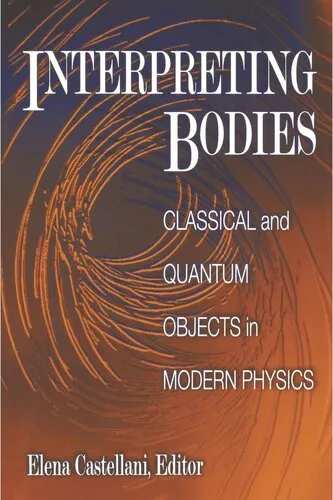Interpreting Bodies: Classical and Quantum Objects in Modern Physics
4.7
بر اساس نظر کاربران

شما میتونید سوالاتتون در باره کتاب رو از هوش مصنوعیش بعد از ورود بپرسید
هر دانلود یا پرسش از هوش مصنوعی 2 امتیاز لازم دارد، برای بدست آوردن امتیاز رایگان، به صفحه ی راهنمای امتیازات سر بزنید و یک سری کار ارزشمند انجام بدینمعرفی جامع کتاب "Interpreting Bodies: Classical and Quantum Objects in Modern Physics"
کتاب "Interpreting Bodies: Classical and Quantum Objects in Modern Physics"، اثری است ادیت شده توسط النا کاسِتلانی که به بررسی برخی از پیچیدهترین و عمیقترین پرسشها درباره ماهیت اشیاء و مفاهیم در فیزیک کلاسیک و کوانتومی میپردازد. این کتاب یک منبع اساسی برای کسانی است که به دنبال درک پیشرفتهتری از ارتباط بین مفاهیم فلسفی و رویکردهای فیزیکی مدرن هستند.
خلاصهای دقیق از محتوای کتاب
این کتاب در یک ساختار چندبخشی، موضوعات چالشبرانگیزی را در مرزهای علم فیزیک و فلسفه کاوش میکند. یکی از بخشهای اصلی کتاب به مطالعه تطبیقی مفهوم "objects" در فیزیک کلاسیک و مکانیک کوانتومی میپردازد. پرسش اساسی این است که چگونه ماهیت اشیاء (از قبیل ذرات، میدانها و سامانهها) در زمینههای مختلف تعریفی بنیادین پیدا میکند؟ آیا اشیائی که در مکانیک نیوتنی تعریف شدهاند همان ویژگیهای اشیاء در مکانیک کوانتومی را دارند؟ تفاوتهای اصلی در چیست و چگونه میتوان این تفاوتها را به لحاظ فلسفی تعبیر کرد؟
بخشهای دیگر کتاب بر اهمیت تفسیر در فیزیک کوانتومی تمرکز دارند. به خصوص، توجه ویژهای به موضوعاتی مانند duality، عدم تعینات (uncertainties) و Superposition شده است. این مباحث باعث بازنگری در مفاهیم عادی ماده، علیت و واقعیت میشود. در نهایت، این کتاب یک پل زدن بین اصطلاحات عمیق فلسفی و ابزارهای ریاضیاتی فیزیک مدرن را هدف قرار داده است.
نکات کلیدی که از کتاب فرا میگیریم
- رابطه بین فلسفه و فیزیک چگونه علوم مدرن را شکل داده است.
- تحول تعریف اشیاء در گذر از فیزیک کلاسیک به مکانیک کوانتومی.
- چگونگی تأثیر اصول اساسی فیزیک کوانتومی بر مفاهیمی نظیر واقعیت و علیت.
- اهمیت تفسیر و تحلیل مفاهیم در علم مدرن.
- چالشهای فلسفی ایجاد شده توسط نظریات نوین در فیزیک.
نقلقولهای مشهور از کتاب
“The classical notion of physical reality seems to dissolve in quantum mechanics, presenting us with a framework where the observer plays a fundamental role.”
“Understanding the ontology of quantum systems demands a reconsideration of what we mean by 'object' itself.”
چرا این کتاب اهمیت دارد؟
کتاب "Interpreting Bodies" تنها یک جستار علمی و فلسفی نبوده و فراتر از آن است؛ این اثر یک پرسش عمیق درباره ماهیت دانش بشری و محدودیت فهم ما از جهان ارائه میدهد. در دنیای مدرن که نظریات فیزیکی به طور فزایندهای با مشاهده و تفسیر ادغام شدهاند، این کتاب چارچوبی ضروری برای هر کسی است که در تلاش است تا ماهیت اشیاء و پدیدهها را در سطحی عمیقتر درک کند.
اهمیت این کتاب نه تنها در پاسخ به برخی از سوالات فلسفی است، بلکه در مطرح کردن سوالات جدیدی قرار دارد که مسیر تحقیقات علمی آینده را روشن خواهد کرد. ارتباط نزدیکی که این کتاب بین دو حوزه فیزیک و فلسفه برقرار میکند نیز آن را به یک اثر برجسته تبدیل کرده است.
Introduction to 'Interpreting Bodies: Classical and Quantum Objects in Modern Physics'
Physics has long been a cornerstone of our understanding of the universe, shaping everything from the smallest particles to the most vast cosmic systems. In 'Interpreting Bodies: Classical and Quantum Objects in Modern Physics', edited by Elena Castellani, readers are invited to explore one of the most pressing philosophical challenges in modern physics: the nature and interpretation of physical objects. Through a collection of essays by leading philosophers of science and physicists, this book provides a deep examination of how the classical and quantum realms intersect, diverge, and inform each other in our quest to grasp the true nature of reality.
Detailed Summary of the Book
At its heart, 'Interpreting Bodies' delves into questions that sit at the boundary of physics and philosophy: What does it mean to be a physical object? How should we understand the profound differences between how "objects" are characterized in classical mechanics and quantum mechanics? The essays within this volume tackle such puzzles, offering a diversity of perspectives and analysis tools to bridge these domains.
The book is divided into thematic sections, each addressing key aspects of the physical and philosophical considerations. Topics range from the ontological status of particles and fields to the conceptual implications of quantum mechanics, such as nonlocality and entanglement. The contributors explore physical objects not merely as entities occupying space and time but also as constructs shaped by mathematical formalisms and experimental practices. It is this interplay of theory and observation that underscores the complexity of interpreting physical objects.
Another central theme of the book is how modern physics necessitates a reevaluation of classical notions of individuality and objectivity in science. With quantum mechanics’ peculiar phenomena, such as wave-particle duality and the superposition of states, the boundaries of physics blur into philosophy, raising critical questions about measurement, determinism, and the limits of human knowledge.
Key Takeaways
- Classical physics provides an intuitive framework for understanding physical objects, but it is challenged by the counterintuitive nature of quantum phenomena.
- Quantum mechanics introduces concepts such as entanglement and superposition, which challenge traditional interpretations of individuality and physical reality.
- The philosophical implications of physics are not secondary to its scientific advancements but are integral to how we define and understand the universe.
- Interconnecting the classical and quantum domains requires more than mathematics; it demands a multidisciplinary dialogue involving philosophy and epistemology.
Famous Quotes from the Book
"The history of physics is not merely a history of empirical discovery; it is also the history of conceptual tools created to make sense of what is observed."
"Modern physics challenges our deepest intuitions about the nature of objects, space, and time. We are forced to rethink the very language we use to describe the physical world."
Why This Book Matters
'Interpreting Bodies' is not just a collection of academic essays; it is a profound engagement with the philosophical foundations of modern scientific thought. In an era where physics continues to push the boundaries of knowledge with discoveries like quantum computing and gravitational waves, understanding the conceptual underpinnings of physical objects assumes critical importance.
This book matters because it ventures into the complex territory of rethinking reality. It provides not only a survey of the philosophical debates surrounding classical and quantum objects but also equips readers with the intellectual tools to engage with these debates on a meaningful level. For physicists, philosophers, and curious readers alike, this compendium serves as a bridge between the scientific and philosophical dimensions of modern physics.
Furthermore, it stands out in its ability to make sophisticated ideas accessible without diminishing their depth. The interdisciplinary insights it offers encourage scholars and thinkers to collaborate across domains, enriching our broader understanding of the universe.
Through its synthetic approach to classical and quantum frameworks, 'Interpreting Bodies' reminds us that the pursuit of science is, at its very core, a philosophical endeavor.
دانلود رایگان مستقیم
برای دانلود رایگان این کتاب و هزاران کتاب دیگه همین حالا عضو بشین
برای خواندن این کتاب باید نرم افزار PDF Reader را دانلود کنید Foxit Reader


